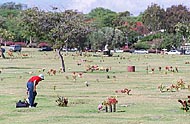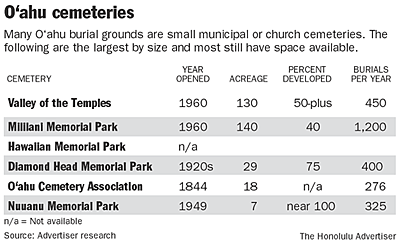By Suzanne Roig
Advertiser East Honolulu Bureau
HAWAI‘I KAI — Henry J. Kaiser saw this day coming when he first envisioned this master-planned community: Hawai‘i Kai is getting older and its needs are changing.
 |
| The almost-full Diamond Head Memorial Park is the nearest major cemetery for East Honolulu residents.
Cory Lum • The Honolulu Advertiser |
There has been a 65.8 percent increase in the number of elderly residents in East Honolulu over the past 20 years, according to John Whalen, a planner at Plan Pacific in Honolulu. And Hawai‘i Kai is expected to gray even more as baby boomers move into their elder years.
Today, East Honolulu, from Kaimuki to Makapu‘u, is one of the areas on O‘ahu with the highest concentration of people older than 65, planners say. Combined with their relative affluence, that makes the area prime for cemetery development, experts say.
Kamval LLC sees the area as an unfilled niche. The developers go before the City Council today for final approval of boundaries for a cemetery they plan to call East O‘ahu Memorial Park.
Some area residents, as well as representatives for some established cemeteries, say there’s no need for another burial ground. There is plenty of space to adequately handle O‘ahu’s needs for the next 20 years, according to cemetery representatives.
But space alone doesn’t drive market demand, say urban planners on O‘ahu. Proximity to home and price have a lot to do with the choices people make.
"Having a cemetery is part of a complete community," Whalen said.
Secularization a trend
At one time, most cemeteries were connected to churches.
Such burial places were small and part of the neighborhood, said Nanette Purnell, founder of the Cemetery Research Project, a directory of graveyards on O‘ahu, Maui and Moloka‘i. Many of these still exist today, picturesque spots that remind us of our history but are no longer used as active burial grounds.
Today, though, "the trend is more of a memorial park with a funeral home and graveyard together," Purnell said. "So you don’t need to go to separate places. It’s a very competitive business."
There are six major cemeteries around O‘ahu and an estimated 71 smaller ones.
Cemeteries in Mililani and in Kane‘ohe, Oahu’s biggest, still have plenty of undeveloped land, about 50 and 60 percent of their total space.
Urban cemeteries such as Diamond Head and Nuuanu plan to build more structures to house urns and coffins above ground to accommodate growth. Hawai‘i leads the nation in cremations per capita.
The biggest cemetery on O‘ahu is in Mililani, with the Windward side having the greatest concentration of cemeteries.
Until recent years, Kane‘ohe and Mililani, were considered rural, with large tracks of open space that cemetery planners found attractive for memorial parks, Purnell said.
An aging community
Henry Kaiser, Hawai‘i Kai’s creator, foresaw the need for a cemetery when the community was in its infancy. He envisioned one at the back of Kamilonui Valley. It just wasn’t necessary when the steel magnate planned Hawai‘i Kai and filled it with young families about 40 years ago.
Today, though, Hawai‘i Kai is no longer a kid.
The increase in the number of residents 65 and older in East Honolulu has outpaced the island as a whole, according to statistics from the East Honolulu Development Plan.
Statistics show that East Honolulu represents about 5 percent of O‘ahu’s total population, with more than 11 percent of those residents 65 years or older in 1990, the last year for which information is available. The Kuli‘ou‘ou-Kalani ‘Iki area has an even higher percentage of retirement-age residents, 17 percent, according to figures from the development plan.
Meanwhile, the median household income is significantly higher in East Honolulu than the rest of O‘ahu, averaging $67,000 in 1990, (the last year for which figures were available) compared with $45,000 islandwide. Housing prices also are higher in East Honolulu. For example, the median sale price for a single-family home in Hawai‘i Kai was $440,000 in 2000, according to the Honolulu Board of Realtors.
In other words, East Honolulu is ready.
John Henry Felix, a City Councilman representing parts of East Honolulu and chairman of the Borthwick Group, which owns and operates mortuaries and cemeteries in Hawai‘i, said there is a need for additional cemetery space.
Felix predicted the operators of the proposed Hawai‘i Kai cemetery could become formidable competitors for established operators.
"There is a need for additional inventory," Felix said. "If the East O‘ahu Memorial Park goes through, they’ll be competing with cemetery plots, mortuary services and crematory services, too. It’s new, and Hawai‘i Kai is a wide-open market for these types of sales.
"Every sustainable community has a memorial park," Feli said.
Some doubt need
But Hal Lewis, superintendent of Oahu Cemetery, said the four crematoriums on O‘ahu and the established cemeteries have plenty of space to accommodate future needs.
"I think they’ll have a hard time in that area; there’s not enough business," Lewis said of Kamval. "I don’t see someone from town driving to Hawai‘i Kai to make arrangements. It’s so far back in the valley."
The death rate is expected to increase as baby boomers age, with the impact being felt within the next 10 years, said Karen Umemoto, University of Hawai‘i assistant professor of urban and regional planning.
But what that means for land use, and whether there is a need for more cemetery space, isn’t clear.
"It’s not just a land-use question," Umemoto said. "It’s a cultural question, too. I don’t know if the baby boomers are wedded to traditional burials and the sites that their parents and grandparents saw as appropriate. There are generational differences."
Traffic called a concern
Kamval LLC, owned by Joe Leoni and Bob Gerell, owns 69 acres of land behind the farm lots in Kamilonui Valley, the same area where Kaiser initially envisioned a cemetery.
The area is rich in ancient Hawaiian archaeological sites, 11 having been identified. No human remains have been found, according to an archaeological study.
If the City Council approves the boundaries, the developers will map out the specifics for the cemetery, positioning locations for burial plots, a mortuary, a crematorium and other buildings that are allowed in a cemetery, Leoni said.
Some residents object to the proposed cemetery because of concerns over traffic and because the area is a known landslide zone. Many have homes next to the road leading to the cemetery.
Because of concerns raised by residents, the developers are required by the city to conduct a soil survey and to fix any problems that arise.
The developers plan to build the cemetery over the next 30 years in three phases. In the end, there will be about 44,000 burial plots and 3,000 niches. Construction is expected to cost $14 million initially, and sales could start in 2003, Leoni said.
"Studies show that the closer your loved ones are, the frequency of visitations go up," Leoni said. "The choice to visit a loved one shouldn’t be limited because of distance. It’s a personal choice. We think we fit a need for Hawai‘i Kai and the east side of Honolulu, particularly since Diamond Head is nearly full. We think it fits the community need."
[back to top] |


